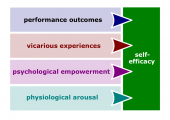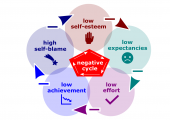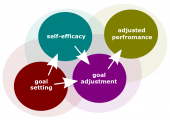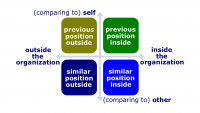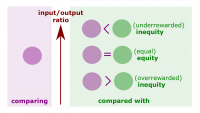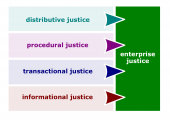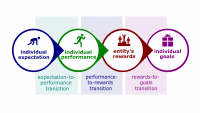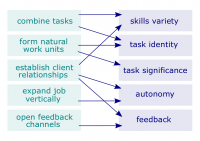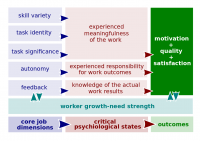Difference between revisions of "OB motivation concepts"
| Line 1: | Line 1: | ||
| − | [[OB motivation concepts]] are those [[concept]]s that are related to [[motivation]] and [[job design]] researched in | + | [[OB motivation concepts]] are those [[concept]]s that are related to [[motivation]] and [[job design]] researched in [[organizational behavior]] studies. The concepts below are taken from [[Organizational Behavior by Robbins and Judge (17th edition)]]; [[Septem Artes Administrativi]] served as the primary source of illustrations. |
Revision as of 02:09, 2 December 2018
OB motivation concepts are those concepts that are related to motivation and job design researched in organizational behavior studies. The concepts below are taken from Organizational Behavior by Robbins and Judge (17th edition); Septem Artes Administrativi served as the primary source of illustrations.
Motivation
- Motivation. The processes that account for an individual's intensity, direction, and persistence of effort toward attaining a goal.
- Hierarchy of needs. Abraham Maslow's hierarchy of five needs -- physiological, safety, social, esteem, and self-actualization -- in which, as each need is substantially satisfied, the next level becomes dominant.
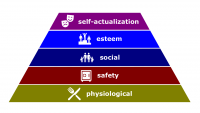 rightHierarchy of needs
rightHierarchy of needs - Two-factor theory (also known as motivation-hygiene theory). A theory that relates intrinsic factors to job satisfaction and associates extrinsic factors with dissatisfaction.
- Hygiene factor. A factor -- such as company policy and administration, supervision, and salary -- that, when adequate in a job, placates workers. When these factors are adequate, people will not be dissatisfied.
- McClelland's theory of needs. A theory that states achievement, power, and affiliation are three important needs that help explain motivation.
- Need for achievement. The drive to excel, to achieve in relationship to a set of standards, and to strive to succeed.
- Need for power. The need to make others behave in a way in which they would not have behaved otherwise.
- Need for affiliation. The desire for friendly and close interpersonal relationships.
- Self-determination theory. A theory of motivation that is concerned with the beneficial effects of extrinsic motivation.
- Cognitive evaluation theory. A version of self-determination theory that holds that allocating extrinsic rewards for behavior intristically rewarding tends to decrease the overall level of motivation if the rewards are seen as controlling.
- Self-concordance. The degree to which people's reasons for pursuing goals are consistent with their interests and core values.
- Goal-setting theory. A theory that says that specific and difficult goals, with feedback, lead to higher performance.
- Promotion focus. A self-regulation strategy that involves striving for goals through advancement and accomplishment.
- Prevention focus. A self-regulation strategy that involves striving for goals by fulfilling duties and obligations.
- Management by objectives. A program that encompasses specific goals, participatively set, for explicit time period, with feedback on goal progress.
- Self-efficacy theory. An individual's belief that he or she is capable of performing a task.
- Reinforcement theory. A theory that says that behavior is a function of its consequences.
- Behaviorism. A theory that argues that behavior follows stimuli in a relatively unthinking manner.
- Social-learning theory. The view that we can learn through both observation and direct experience.
- Equity theory. A theory that says that individuals compare their job inputs and outcomes with those of others and then respond to eliminate any inequities.
- Organizational justice. An overall perception of what is fair in the workplace, composed of distributive, procedural, informational, and interpersonal justice.
- Distributive justice. Perceived fairness of the amount and allocation of rewards among individuals.
- Procedural justice. The perceived fairness of the process used to determine the distribution of rewards.
- Informational justice. The degree to which employees are provided truthful explanations for decisions.
- Interpersonal justice. The degree to which employees are treated with dignity and respect.
- Expectancy theory. A theory that says that the strength of a tendency to act in a certain way depends on the strength of an expectation that the act will be followed by a given outcome and on the attractiveness of that outcome to the individual.
- Job engagement. The investment of an employee's physical, cognitive, and emotional energies into job performance.
Motivation applications
- Job design. The way the elements in a job are organized.
- Job characteristics model. A model that proposes that any job can be described in terms of five core job dimensions: skill variety, task identity, task significance, autonomy, and feedback.
- Skill variety. The degree to which a job requires a variety of different activities.
- Task identity. The degree to which a job requires completion of a whole and identifiable piece of work.
- Task significance. The degree to which a job has a substantial impact on the lives or work of other people.
- Autonomy. The degree to which a job provides substantial freedom and discretion to the individual in scheduling the work and in determining the procedures to be used in carrying it out.
- Feedback. The degree to which carrying out the work activities required by a job results in the individual obtaining direct and clear information about the effectiveness of his or her performance.
- Motivating potential score. A predictive index that suggests the motivating potential in a job.
- Job rotation. The periodic shifting of an employee from one task to another.
- Relational job design. Constructing jobs so employees see the positive difference they can make in the lives of others directly through their network.
- Flextime. Flexible work hours.
- Job sharing. An arrangement that allows two or more individuals to split a traditional 40-hour-a-week job.
- Telecommuting. Working remotely at least 2 days a week on a computer that is linked to the employer office.
- Employee involvement and participation. A participative process that uses the input of employees to increase employee commitment to organizational success.
- Participative management. A process in which subordinates share a significant degree of decision-making power with their immediate superiors.
- Representative participation. A system in which workers participate in organizational decision making through a small group of representative employees.
- Variable-pay program. A pay plan that bases a portion of an employee's pay on some individual and/or organizational measure of performance.
- Piece-rate pay plan. A pay plan in which workers are paid a fixed sum for each unit of production completed.
- Merit-based pay plan. A pay plan based on performance appraisal ratings.
- Bonus. A pay plan that rewards employees for recent performance rather than historical performance.
- Profit-sharing plan. An organization-wide program that distributes compensation based on some established formula designed around a company's profitability.
- Employee stock ownership plan. A company-established benefits plan in which employees acquire stock, often at below-market prices, as part of their benefits.
- Flexible benefits. A benefits plan that allows each employee to put together a benefits package individually tailored to his or her own needs and situation.
- Employee recognition program. A plan to encourage specific employee behaviors by formally appreciating specific employee contributions.
